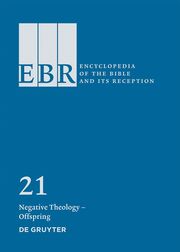Detailansicht
Negative Theology - Offspring
Encyclopedia of the Bible and Its Reception (EBR) 21
ISBN/EAN: 9783110628272
Umbreit-Nr.: 5798676
Sprache:
Englisch
Umfang: XXIX, 643 S., 34 s/w Illustr., 21 farbige Illustr.
Format in cm:
Einband:
Leinen
Erschienen am 22.05.2023
Auflage: 1/2023
- Zusatztext
- The projected thirty-volume Encyclopedia of the Bible and Its Reception (EBR) is intended to serve as a comprehensive guide to the current state of knowledge on the background, origins, and development of the canonical texts of the Bible as they were accepted in Judaism and Christianity. Unprecedented in breadth and scope, this encyclopedia also documents the history of the Bibles interpretation and reception across the centuries, not only in Judaism and Christianity, but also in literature, visual art, music, film, and dance, as well as in Islam and other religious traditions and new religious movements. The EBR is also available online. Bloggers Choice - Articles recommended by biblioblogger Jim West (https://zwingliusredivivus.wordpress.com): Matthew Page (Loughborough, United Kingdom), Nehemiah (Book and Person) VIII. Film. Nehemiah receives scant treatment in film. Page remarks "Compared to most major biblical stories, filmmakers have largely overlooked the book of Nehemiah and its hero." Indeed, as he describes things, the only full-length treatment of Nehemiah is a film produced by the Jehovahs Witnesses. The film, titledNehemiah: The Joy of Jehovah Is Your Stronghold(prod. Watch Tower Bible and Tract Society, was produced only as recently as 2020. These are the sorts of amazing details that come to light in theEBR. And these details are whyEBRis such an incredible, and important resource. Ada Taggar-Cohen (Kyoto, Japan), Neo-Hittites. "As successors to the Hittite Empire that stretched from central Anatolia into north Syria until 1180 BCE, the people who lived after its collapse in the regions of southeastern Anatolia and northern Syria are known as Neo-Hittites." Taggar-Cohen then delves into the topics of the history, the cultural evidence, and, this being anEncyclopedia of the Bible and Its Reception, the Neo-Hittites and the Bible. Also included is a very thorough bibliography. This entry is both interesting and well written. A real quality piece of scholarship. Miryam Brand (Jerusalem, Israel), Nephilim III. Judaism A. Second Temple and Hellenistic Judaism. Brand notes that in texts from the Second Temple period and the Hellenistic era "The Nephilim play a central role in a popular Second Temple era story regarding the origin of evil: the myth of the Watchers." To illustrate the point, she follows her opening declaration with evidence from 1 Enoch, Jubilees, the Dead Sea Scrolls, and Philo. Very much appreciated is her succinct summary of the tales of the Nephilim: "In the fullest form of this story, angels mated with human women and produced giant children who caused destruction, while the angels themselves caused sin by teaching humans illicit knowledge. When the physical bodies of these giants were destroyed, they became evil spirits that plagued the earth." Jörg Frey (Zurich, Switzerland), Nicodemus I. New Testament. Nicodemus is only named in the Gospel of John. Who he was seems less important than the portrayals foisted on him by the readers of that Gospel. At least thats what Frey seems to suggest when he concludes his entry on Nicodemus in the New Testament with the following lines: "For reading the gospel text, the question of the historical reference of the figure remains of secondary importance. Instead, it is the literary ambivalence of the figure that has stimulated readers up to the present to create their own image of Nicodemus." Nicodemus as Rorschach test. Thats the fate of all the characters of the Bible about whom we know so little. What we do know, however, is all described by Frey in his helpful entry. Adam ajtar (Warsaw, Poland)NubiaII. Christian Textual Traditions. ajtars discussion centers on the Christian Textual Traditions of Nubia. He observes "Christian Nubia had a rich literary culture, testament to which are 4,000 entries in the internet Database of Medieval Nubian Texts (DBMNT)." All manner of texts are included in these materials including, but not limited to liturgical texts, patristic texts, biblical texts, and many others. Adams contribution to the EBR Haven, CT, USA), Obscenity and Euphemism III. Judaism B. Rabbinic Judaism. Rabbinic Judaism was no stranger to the use of obscenity, according to Kamholz. "Rabbinic treatment of biblical texts which use language or describe imagery that could be considered obscene falls into two broad categories. The first is euphemism, avoidance, or restatement; the second is emphasizing and even increasing the obscenity of the original text." She then provides very intriguing examples of these usages. Of the articles I read, I think I learned the most from this one. I certainly enjoyed it a great deal.
- Kurztext
- The Encyclopedia of the Bible and Its Reception (EBR) pursues a twofold task. Firstly, it comprehensively renders the current state of knowledge on the origins and development of the Bible according to its different canonic forms in Judaism and Christianity. Secondly, it documents the history of the Bible's reception, not only in the Christian churches and the Jewish Diaspora, but also in literature, art, music, and film, as well as Islam and other religious traditions and current religious movements.
